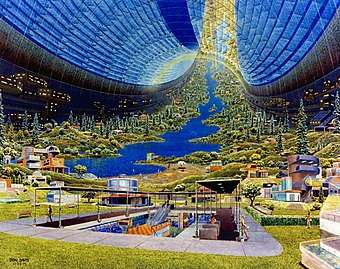L5 Society
The L5 Society was founded in 1975 by Carolyn Meinel and Keith Henson to promote the space colony ideas of Gerard K. O'Neill.[1]
.svg.png)
In 1987 the L5 Society merged with the National Space Institute to form the National Space Society.[2]
Name

The name comes from the L4 and L5 Lagrangian points in the Earth–Moon system proposed as locations for the huge rotating space habitats that O'Neill envisioned. L4 and L5 are points of stable gravitational equilibrium located along the path of the Moon's orbit, 60 degrees ahead or behind it.[2]
An object placed in orbit around L5 (or L4) will remain there indefinitely without having to expend fuel to keep its position, whereas an object placed at L1, L2 or L3 (all points of unstable equilibrium) may have to expend fuel if it drifts off the point.
History
Founding of L5 Society

O'Neill's first published paper on the subject, "The Colonization of Space", appeared in the magazine Physics Today in September 1974. A number of people who later became leaders of the L5 Society got their first exposure to the idea from this article. Among these were a couple from Tucson, Arizona, Carolyn Meinel and Keith Henson. The Hensons corresponded with O'Neill and were invited to present a paper on "Closed Ecosystems of High Agricultural Yield" at the 1975 Princeton Conference on Space Manufacturing Facilities, which was organized by O'Neill.[3]
At this conference, O'Neill merged the Solar Power Satellite (SPS) ideas of Peter Glaser with his space habitat concepts.[4]
The Hensons incorporated the L5 Society in August 1975, and sent its first 4-page newsletter in September to a sign up list from the conference and O'Neill's mailing list.[5] The first newsletter included a letter of support from Morris Udall (then a contender for US president) and said "our clearly stated long range goal will be to disband the Society in a mass meeting at L5."[6]
Moon Treaty
The peak of L5's influence was the defeat of the Moon Treaty in the U.S. Senate in 1980 ("... L-5 took on the biggest political fight of its short life, and won").[3] Specifically, L5 Society activists campaigned for awareness of the provisions against any form of sovereignty or private property in outer space that would make space colonization impossible and the provisions against any alteration of the environment of any celestial body prohibiting terraforming. Leigh Ratiner [a Washington lawyer/lobbyist] "played the key role in the lobbying effort, although he had energetic help from L-5 activists, notably Eric Drexler and Christine Peterson."[7][8]
Although economic analysis [9] indicated the SPS/space colony concept had merit, it foundered on short political and economic horizons and the fact that the transport cost to space was about 300 times too high for individuals to fund when compared to the Plymouth Rock and Mormon colonies.[10]
Merger with National Space Institute

In 1986, the L5 Society, which had grown to about 10,000 members, merged with the 25,000 member National Space Institute, to form the present-day National Space Society. The National Space Institute had been founded in 1972 by Wernher von Braun, the former German rocket engineer of the WW II Nazi V-2 rocket/ballistic missile program, and of NASA's Marshall Space Flight Center and Project Apollo program manager.[11]
While the L5 Society failed to achieve the goal of human settlements in space, it served as a focal point for many of the people who later became known in fields such as nanotechnology, memetics, extropianism, cryonics, transhumanism, artificial intelligence, and tether propulsion, such as K. Eric Drexler, Robert Forward, and Hans Moravec.[12][13]
L5 News
The L5 News[14] was the newsletter of the L5 Society reporting on space habitat development and related space issues. The L5 News was published from September 1975 until April 1987, when the merger with the National Space Institute was completed and the newly formed National Space Society began publication of its own magazine, Ad Astra.
See also
- List of objects at Lagrangian points
- Home on Lagrange (The L5 Song)
- Space advocacy organizations
- Space colonization topics
References
- Dorminey, Bruce (July 31, 2012). "Death Of A Sci-Fi Dream: Free-Floating Space Colonies Hit Economic Reality". Forbes. Retrieved December 17, 2018.
- Brandt-Erichsen, David (November 1994). "Brief History of the L5 Society". National Space Society. Retrieved December 17, 2018.
- Chapter 5: O'Neills Children Archived 2016-12-10 at the Wayback Machine, Reaching for the High Frontier, The American Pro-Space Movement 1972–84, by Michael A. G. Michaud, National Space Society.
- Pg 5, Archive for December, 1975, Space Studies Institute
- Brandt-Erichsen, David. The L5 Society. "Reprinted from Ad Astra, the magazine of the National Space Society, Nov.-Dec., 1994." Ad Astra, November/December 1994. Retrieved from http://www.nss.org/settlement/L5news/L5history.htm.
- L-5 News, 1975, L-5 News, A Newsletter from the L-5 Society, Number 1, September 1975
- O'Neill, Gerard K. "Space Colonies and Energy Supply to the Earth," Science 190:943–947. December 5, 1975
- See the chapter "Pilgrims, Saints and Spacemen" in Freeman Dyson's Disturbing the Universe for an analysis.
- "About the National Space Society (NSS)". Archived from the original on 2008-12-18. Retrieved 2009-12-24.
- A journalistic account can be found in Great Mambo Chicken and the Transhuman Condition by Ed Regis (1990 – ISBN 0-201-09258-1).
- A more scholarly treatment is the 2012 book The Visioneers by historian W. Patrick McCray.
- L5 News
External links
- NSS.org: Official NSS−National Space Society website
- NSS.org: Ad Astra Online — online edition of Ad Astra magazine.
- NSS Worldwide website
- Chapters.nss.org: National Space Society Chapters Network Resources for NSS chapters, members and space activists.
- NSS Chapters Story
- 1979 UN Declaration on the Moon (Moon Treaty)
- L5 News index